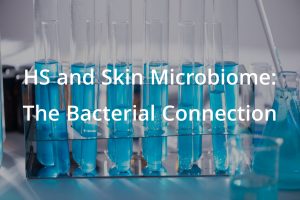
HS and Skin Microbiome: The Bacterial Connection
Hidradenitis Suppurativa (HS) is a chronic skin condition characterized by painful abscesses and scarring, primarily affecting areas with sweat glands. While the exact cause of HS remains unclear, emerging research suggests a significant link between the skin microbiome and the development of this condition. Understanding the role of bacterial imbalances may not only shed light on HS’s pathophysiology but also open new avenues for innovative therapeutic approaches. This blog delves into the connection between the microbiome and HS, exploring how disruptions in bacterial communities may contribute to HS and discussing potential treatments that target these imbalances.
Understanding the Skin Microbiome
The human skin hosts a diverse community of microorganisms, including bacteria, fungi, and viruses, collectively known as the microbiome. In healthy individuals, this microbiome exists in balance, protecting against pathogens and contributing to the immune system’s proper functioning. However, disturbances in this microbial community can lead to or exacerbate skin disorders, including HS.
The Microbiome’s Role in HS
- Bacterial Imbalance and Inflammation: Recent studies indicate that patients with HS often exhibit altered microbiomes in affected skin areas. These imbalances might contribute to the condition’s inflammatory nature. Specific bacteria, such as anaerobes or opportunistic pathogens, can overgrow and trigger immune responses, leading to the deep, painful nodules characteristic of HS.
- Link Between Gut Health and Skin Condition: Growing evidence supports the gut-skin axis theory, which suggests that gut health significantly impacts skin health. In HS, the gut’s dysbiosis (a microbial imbalance) can also influence skin conditions, potentially exacerbating skin inflammation and immune dysfunction.
- Antibiotic Resistance: The chronic use of antibiotics in HS treatment can lead to antibiotic resistance, complicating disease management. This resistance further disrupts the skin microbiome, creating a cycle that can perpetuate the condition and make it difficult to treat effectively.
Therapeutic Approaches Targeting the Microbiome
Understanding the microbiome’s role in HS opens new therapeutic avenues for restoring microbial balance and enhancing overall skin and gut health.
- Probiotics and Prebiotics: These supplements aim to restore the normal flora of the microbiome. Probiotics introduce beneficial bacteria, whereas prebiotics provide the nutrients needed to support healthy microbial communities. For HS patients, probiotics could help manage skin inflammation by restoring a healthy balance of bacteria.
- Dietary Modifications: Since gut health significantly affects the skin, HS patients might benefit from dietary changes that support a healthy microbiome. Diets rich in fiber, low in processed foods, and high in anti-inflammatory components can help reduce systemic inflammation and support microbial diversity.
- Topical Probiotics: Applying probiotics directly to the skin is an emerging treatment that could help restore microbial balance and reduce inflammation. Early research suggests these topical treatments could decrease the colonization of harmful bacteria and restore a protective barrier to the skin.
- Phage Therapy: Bacteriophages, viruses that infect and kill specific bacteria strains, represent a novel approach to addressing bacterial imbalance. Phage therapy could target and eliminate pathogenic bacteria associated with HS without disrupting the overall microbiome as broadly as antibiotics.
Research and Future Directions
While the connection between the microbiome and HS is a relatively new field of study, it offers significant promise for developing more effective and targeted treatments. Ongoing research aims to understand better the specific changes in the microbiome associated with HS, how these changes affect disease progression, and which treatments can most effectively restore balance and reduce symptoms.
Conclusion
Exploring the microbiome’s role in Hidradenitis Suppurativa represents a crucial step forward in understanding and treating this challenging condition. Medical professionals can develop more targeted, practical therapies beyond symptom management to address the condition’s underlying causes by focusing on the bacterial imbalances that may contribute to HS. For patients suffering from HS, these advances offer hope for more effective management strategies and a higher quality of life. As research continues to unfold, microbiome-targeted therapies will likely become integral to HS treatment regimens, tailored to individual patient needs and specific microbial profiles.
